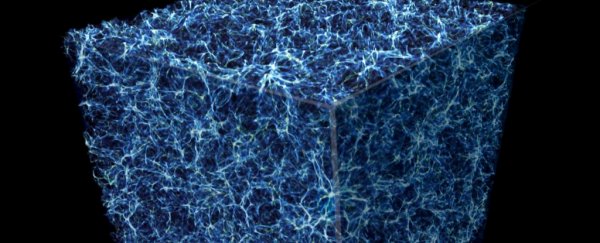Strange voids out there in space – pockets of near nothingness between galaxies – could be crucial in measuring the expansion of the Universe with greater precision than we've ever managed before, new research says.
Experts have been able to use a new method to accurately measure the distortion caused by Doppler shifts on the shapes of voids – the way the light emitted by cosmic objects changes wavelength as they get closer to or further away from us – which in turn tells us more about how the Universe is expanding.
Importantly, measuring the shape of the voids could teach us more about the properties of dark energy and dark matter, the mysterious forces thought to make up 95 percent of the Universe.
Dark matter is thought to help hold galaxies together, while dark energy accelerates the expansion of the Universe.'
Below you can see the change in the average shape of voids caused by Doppler distortions and the effects of dark energy.
 (University of Portsmouth)
(University of Portsmouth)
What's especially exciting is that this technique could unlock extra information from the Baryon Oscillation Spectroscopic Survey (BOSS), a detailed chart of where galaxies are positioned based on the rippling of sound waves formed at the beginning of the Universe.
"This measurement tremendously upgrades the previous best results from BOSS," says cosmologist Seshadri Nadathur, from the Institute of Cosmology and Gravitation (ICG) at the University of Portsmouth in the UK.
"The precision is equivalent to getting data from a hypothetical survey four times as large as BOSS, completely for free. It really helps pin down the properties of dark energy."
The work that Nadathur and his team have done has already answered some of the questions astronomers have got about the Universe – or at least limited the number of potential answers, anyway.
Based on the readings taken so far, we're living in the simplest model of a flat Universe, with a cosmological dark energy that's constant and fixed. With so many competing hypotheses on the table, any way to rule out one or two can be helpful.
The new study relies on the Sloan Digital Sky Survey (SDSS) and a sampling of enough voids – while these voids are a variety of shapes, they can be aligned in all kinds of ways, so if enough of them can be measured then scientists can end up with what an average void sphere should look like.
Any variations on that average are caused by travel through space, neighbouring galaxies, and the influence of dark energy and dark matter. By measuring these variations, our picture of space becomes much more detailed.
The new approach marks a substantial upgrade over the baryon acoustic oscillation (BAO) technique currently in use, the sound wave measurements that BOSS is based on.
Previous research helped experts look into the pressure and the temperature of the voids that exist out in space, and the latest study adds even more to the picture, giving us the best look yet at why galaxies are moving the way they are.
And the researchers aren't done with their new approach yet: It's likely to improve on the results we get from numerous telescope observations and other studies, like switching from HD to 4K on a video stream.
"These results also mean that the expected science results from facilities such as the European Space Agency's Euclid satellite mission and the Dark Energy Spectroscopic Instrument – in which the astronomy community have invested a lot of resources – can be even better than previously thought," says Nadathur.
The research has been published in Physical Review D.
